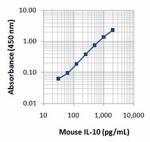- Clone
- MK10A6 (See other available formats)
- Regulatory Status
- RUO
- Other Names
- Interleukin-10, Cytokine synthesis inhibitory factor (CSIF), B cell derived T cell growth factor (B-TCGF), T cell growth inhibitory factor (TGIF)
- Isotype
- Rat IgG1, κ
- Ave. Rating
- Submit a Review
- Product Citations
- publications

| Cat # | Size | Price | Quantity Check Availability | Save | ||
|---|---|---|---|---|---|---|
| 521801 | 50 µg | £61 | ||||
| 521802 | 500 µg | £182 | ||||
IL-10 was first described as a cytokine that is produced by T helper 2 (Th2) cell clones. It inhibits interferon gamma (IFN-γ) synthesis in Th1 cell, and therefore it was initially called cytokine synthesis inhibiting factor (CSIF). Macrophages are the main source of IL-10, and its secretion can be stimulated by endotoxin (via Toll-like receptor 4, NF-κB dependent), tumor necrosis factor TNF-α (via TNF receptor p55, NF-κB-dependent), catecholamines, and IL-1. IL-10 controls inflammatory processes by suppressing the expression of proinflammatory cytokines, chemokines, adhesion molecules as well as antigen-presenting and costimulatory molecules in monocytes/macrophages, neutrophils, and T cells. IL-10 inhibits the production of proinflammatory mediators by monocytes and macrophages such as endotoxin- and IFNγ-induced release of IL-1α, IL-6, IL-8, G-CSF, GM-CSF, and TNF-α. In addition, it enhances the production of anti-inflammatory mediators such as IL-1RA and soluble TNF-α receptors. IL-10 inhibits the capacity of monocytes and macrophages to present antigen to T cells. This is realized by downregulation of constitutive and IFNγ-induced cell surface levels of MHC class II, of costimulatory molecules such as CD86, and of some adhesion molecules such as CD58.
Product DetailsProduct Details
- Verified Reactivity
- Mouse
- Antibody Type
- Monoclonal
- Host Species
- Rat
- Formulation
- Phosphate-buffered solution, pH 7.2, containing 0.09% sodium azide.
- Preparation
- The antibody was purified by affinity chromatography.
- Concentration
- 0.5 mg/ml
- Storage & Handling
- The antibody solution should be stored undiluted between 2°C and 8°C.
- Application
-
ELISA Capture - Quality tested
- Recommended Usage
-
Each lot of this antibody is quality control tested by ELISA assay. For ELISA capture applications, a concentration range of 2-8 µg/ml is recommended. To obtain a linear standard curve, serial dilutions of IL-10 recombinant protein ranging from 2000 to 31.3 pg/ml are recommended for each ELISA plate. It is recommended that the reagent be titrated for optimal performance for each application.
- Application Notes
-
ELISA Capture: The purified MK10A6 antibody is useful as the capture antibody in a sandwich ELISA assay, when used in conjunction with the biotinylated JES5-16E3 antibody (Cat. No. 505003) as the detecting antibody and recombinant mouse IL-10 (Cat. No. 575809) as the standard.
Note: For testing mouse IL-10 in serum, plasma or supernatant, BioLegend's LEGEND MAX™ Kits (Cat. No. 431417 & 431418) are specially developed and recommended. - RRID
-
AB_2561713 (BioLegend Cat. No. 521801)
AB_2561714 (BioLegend Cat. No. 521802)
Antigen Details
- Structure
- Acid-labile cytokine, dimer, 17-21 kD (Mammalian)
- Distribution
- IL-10 is produce by Th2 cells, macrophages, DCs, B cells, CD8+ T cells, regulatory T cells (Tregs), Th1 cells and Th17 cells. In addition, IL-10 is expressed by monocytes, B cells, eosinophils, and mast cells.
- Function
- IL-10 is an immunoregulatory cytokine. Its main function is the limitation and termination of inflammatory responses and the regulation of differentiation and proliferation of several immune cells such as T cells, B cells, natural killer cells, antigen-presenting cells, mast cells, and granulocytes.
- Interaction
- IL-10R is expressed in monocytes, NK, B, and T cells. In addition Langerhans cells, dermal dendritic cells, eosinophils, mast cells, and endothelial cells can respond to IL-10.
- Ligand/Receptor
- IL-10 binds to their receptors IL-10R1 and IL-10R2, and initiates a STAT3-dependent signaling cascade.
- Biology Area
- Immunology
- Molecular Family
- Cytokines/Chemokines
- Antigen References
-
1. Fiorentino DF, et al. 1989. J. Exp. Med. 170:2081.
2. Ho AS, et al. 1993. Proc. Natl. Acad. Sci. USA 90:11267.
3. Hart PH, et al. 1996. J. Immunol. 157:3672.
4. Asadullah K, et al. 2003. Pharmacol. Rev. 55:241.
5. Mosser DM and Zhang X. 2008. Immunol. Rev. 226:205.
6. Maynard CL and Weaver CT. 2008. Immunol. Rev. 226:219. - Gene ID
- 16153 View all products for this Gene ID
- UniProt
- View information about IL-10 on UniProt.org
Related FAQs
Other Formats
View All IL-10 Reagents Request Custom Conjugation| Description | Clone | Applications |
|---|---|---|
| Purified anti-mouse IL-10 | MK10A6 | ELISA Capture |
Compare Data Across All Formats
This data display is provided for general comparisons between formats.
Your actual data may vary due to variations in samples, target cells, instruments and their settings, staining conditions, and other factors.
If you need assistance with selecting the best format contact our expert technical support team.
 Login / Register
Login / Register 











Follow Us